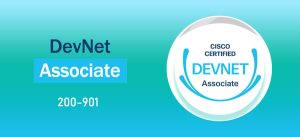Cisco Latest Network System and practice test – 2022 Update
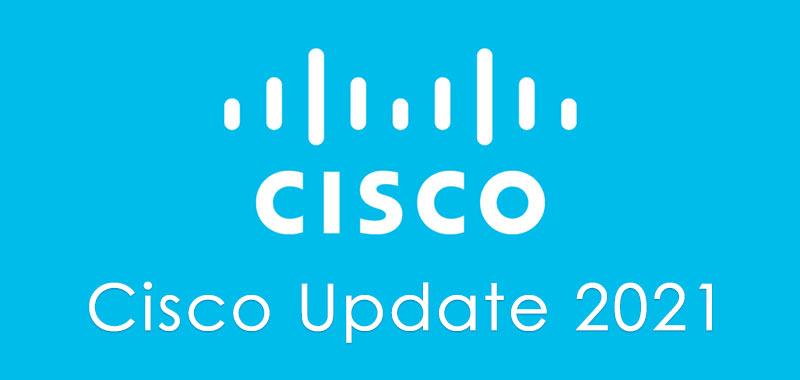
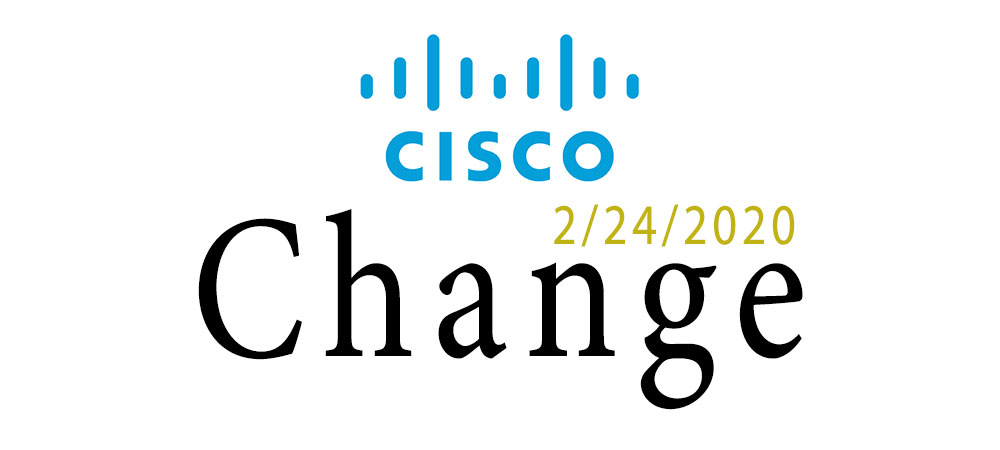
Summary of the Main Changes
- The changes come into effect on February 24th 2020
- All certification tracks and levels are affected
- The main certification levels remain the same – CCNA, CCNP and CCIE
- The different tracks are being removed at the CCNA level
- The tracks are being consolidated at the CCNP and CCIE level
- The entry-level CCENT certification is being retired
- The recertification period for all certifications will be 3 years
CCNA Cisco Certified Network Associate
Current CCNA Tracks before February 24th:
- CCNA Routing and Switching
- CCNA Cloud
- CCNA Collaboration
- CCNA Cyber Ops
- CCNA Data Center
- CCNA Industrial
- CCNA Security
- CCNA Service Provider
- CCNA Wireless
- CCDA Design
New CCNA Tracks from February 24th:
- CCNA
- Cisco Certified DevNet Associate (new)
The 10 current CCNA tracks will no longer be available from 24th February 2020. Way back in the day when Cisco was originally a routing and switching company, they released the CCNA certification which was the equivalent of today’s CCNA Routing and Switching. Whenever somebody mentions the ‘CCNA’ in general, they’re talking about the CCNA R&S.
Cisco went on to expand into other technology areas such as Security with devices like the PIX firewall (now the ASA) and Collaboration with products such as Cisco CallManager (now the Cisco Unified Communications Manager). The certification evolved to include the new technologies, with CCNA Security, CCNA Collaboration, etc. tracks being added, eventually culminating in the 10 tracks available now.
Having 10 different CCNA tracks can be confusing both for new network engineers wishing to get certified and also for employers. Another concern is that engineers working on real-world Cisco networks are typically expected to have skills across multiple tracks, and the current certification program means they have to either study all the different tracks which would be very time consuming and expensive, or pick up knowledge on the job without a structured study showing the right way to do things.
Cisco is addressing this by consolidating the 10 current tracks into a single CCNA certification which covers foundational level knowledge across all of them. Network automation and programmability are also included.
Cisco offers official 5-day classroom courses for each of the current tracks. The course material for the new CCNA exam hasn’t been released yet, but I expect it will also be a 5-day class (or maybe 10 days). Obviously, you can’t fit 10 weeks of training into 1 or 2 weeks, so the more advanced material will be pushed up to the CCNP level exams.
Required Exams for CCNA
To achieve the CCNA Routing and Switching before February 24th, you can EITHER:
Take BOTH the ICND1 100-105 (which gets you the CCENT) AND ICND2 200-105 exams
OR
Take the single CCNA 200-125 exam
To achieve the CCNA after February 24th:
Take the single CCNA 200-301 exam
Everything is normal until February 23, 2020! However, if you get certified after February 24, you will receive a new certification and related certificate! Below you will learn about the main updates for cisco CCNA, CCNP, CCIE certification!
Content from: https://www.flackbox.com/cisco-ccna-ccnp-ccie-certification-update-2020
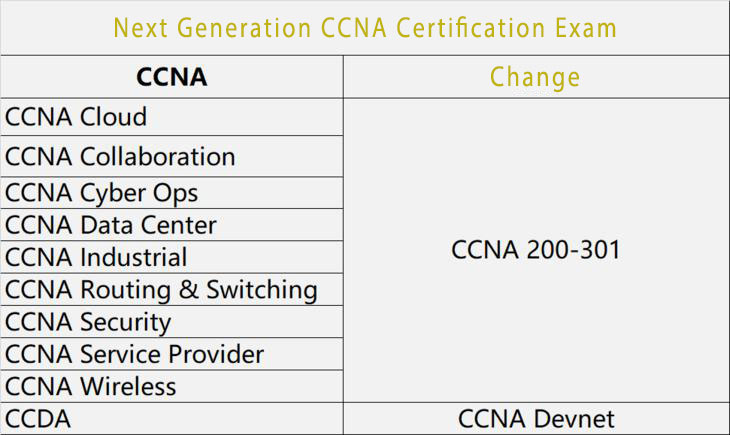
UPDATE: You can find the list of topics on the new CCNA 200-301 exam here:
https://www.cisco.com/content/dam/en_us/training-events/le31/le46/cln/marketing/exam-topics/200-301-CCNA.pdf
Cutover Date
The last day to take any of the current exams is February 23rd, 2020, and the first day to take new exams is February 24th, 2020. When Cisco certifications have been updated in the past, there’s usually a transitional period of around 3 months where both the old and new exams are available. Because this is such a major update Cisco is doing a clean cutover on a specific date.
If you achieve certification before February 24th, you will automatically receive the equivalent new certification after the cutover date. You will need to recertify 3 years after the date you attained the certification. For example, if you achieve the CCNA with the current exam on January 1st, 2020, you will still be a CCNA after the cutover date, and you will need to recertify (with the latest version of the exam) on January 1st, 2023.
Cisco Certified DevNet Associate
Network programmability and automation is a comparatively new technology that is becoming more prevalent, particularly in Service Provider and large enterprise environments. Cisco is releasing the new Cisco Certified DevNet Associate certification to give engineers the knowledge and skills to program network environments. It’s aimed at developers who want to learn how to use their skills in networks, or network engineers who are cross-training into programming.
What Should You Do If You Have Already Begun Studying For the CCNA?
My online CCNA course includes a suggested timetable to complete your studies in 6 weeks. If you’re reading this before December 2019, I highly recommend that you take the current exam (or the ICND1 and ICND2 exams) to get your CCNA before the changeover. There are 12 weeks from December 1st until the changeover so you have plenty of time.
The benefits you get from doing this are:
- You retain the qualification after the changeover without having to study all the new topics in the new exam.
- You will have advanced Routing and Switching skills you can use on the job and while studying to attain the CCNP Enterprise.
- You will be immediately qualified for that new job or promotion you want.
- You can move on to the next certification and keep moving up the career ladder NOW.
Waiting for the new exam is a cop-out and just procrastinating. Don’t waste time with your career, get ahead now. You can take it easy once you’ve got the qualifications done and have your dream job.
CCENT Cisco Certified Entry Networking Technician
The CCENT certification is being retired from February 24th, 2020. The qualification is not well known to employers, and job adverts for network positions typically require at least the CCNA.
If you have already passed the CCENT with the ICND1 100-105 exam, I highly recommend you upgrade to the CCNA by taking the ICND2 200-105 exam before the changeover. If you don’t do so you will need to take the new 200-301 exam to get your CCNA.
CCNP Cisco Certified Network Professional
Current CCNP Tracks before February 24th:
- CCNP Routing and Switching
- CCNP Cloud
- CCNP Collaboration
- CCNP Data Center
- CCNP Security
- CCNP Service Provider
- CCNP Wireless
- CCDP Design
(No Cyber Ops or Industrial tracks unlike the CCNA)
New CCNP Tracks from February 24th:
- CCNP Enterprise (covers Wired and Wireless)
- CCNP Data Center
- CCNP Security
- CCNP Service Provider
- CCNP Collaboration
- Cisco Certified DevNet Professional (new)
CCNP Change
Original CCNP RS and CCNP Wireless direction combined into CCNP Enterprise direction

CCNP examination form changes, originally need 3-5 written tests all passed, the next generation OF CCNP certification only need to pass 2 exams can be obtained, that is, must take a core examination, plus an optional exam
Next-generation CCNP can be certified directly without CCNA certification
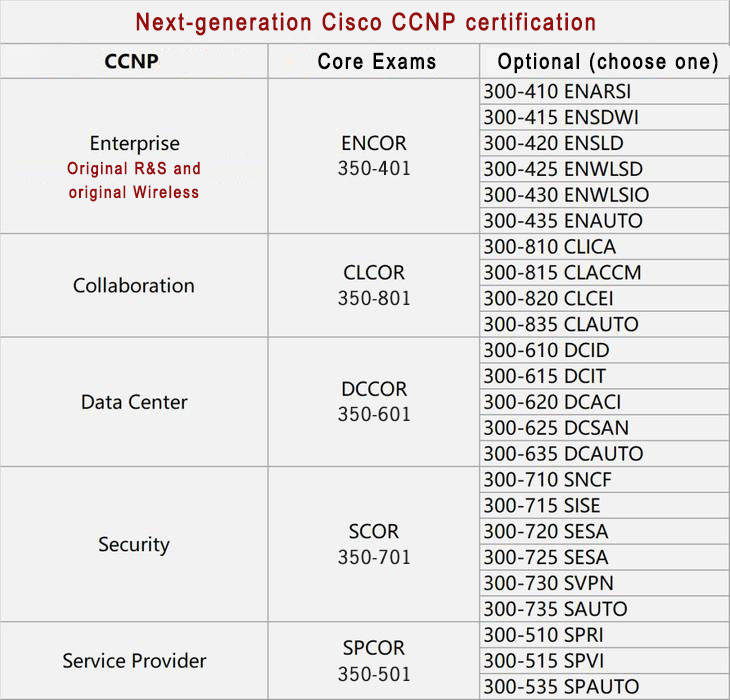
Required Exams for CCNP:
Before February 24th, you need to pass 3 or 4 (depending on the track) exams to attain each CCNP.
From February 24th, you need to pass 2 exams for each track:
- A technology core exam – covers foundational and common concepts
- A concentration exam – a deeper dive into the technology
Under the current rules, you usually have to have at least the CCENT to get a CCNP certification. After the changeover, there are no prerequisite exams.
CCNP Transition:
If you pass any CCNP level exams before February 24, you’ll receive badging for corresponding new exams and credit toward the new CCNP certification.
UPDATE: You can check what credit you will receive in the new program for passing CCNP level exams before February 24th with the CCNP Migration Tools here:
https://www.cisco.com/c/en/us/training-events/training-certifications/certifications/professional/ccnp-migration-tools.html
As with the CCNA, if you achieve certification before February 24th, you will automatically receive the equivalent new certification after the cutover date. You will need to recertify 3 years after the date you attained the certification.
CCIE Cisco Certified Internetwork Expert
Current CCIE Tracks before February 24th:
- CCNP Routing and Switching
- CCNP Collaboration
- CCNP Data Center
- CCNP Security
- CCNP Service Provider
- CCNP Wireless
- CCDP Design
(No Cloud track unlike the CCNP)
New CCIE Tracks from February 24th:
- CCNP Enterprise Infrastructure (focuses on wired networks)
- CCNP Enterprise Wireless
- CCIE Data Center
- CCIE Security
- CCIE Service Provider
- CCIE Collaboration
Cisco Certified DevNet Expert is planned but the date it will be available has not been released yet.
Required Exams for CCIE:
Before February 24th, you need to do a written and a lab exam for each track.
From February 24th, you need to pass 2 exams for each track:
- A technology core exam – same as for CCNP
- A lab exam with 2 modules:
- Design (3 hours)
- Deploy, Operate and Optimize (5 hours)
Automation and Network Programmability is being added in the new exams.
As before there are no prerequisite exams you need to take before the CCIE. After the changeover, you need to recertify every 3 years, unlike the current rule which is every 2 years.
CCIE Change
RS exit stake in history stage, RS direction changed to Enterprise direction, existing RS certification automatically upgraded to enterprise infrastructure certification after the release of new certification
Design direction changed to DevNet direction, CCDA to DevNet Associate, CCDP to DevNet Professional
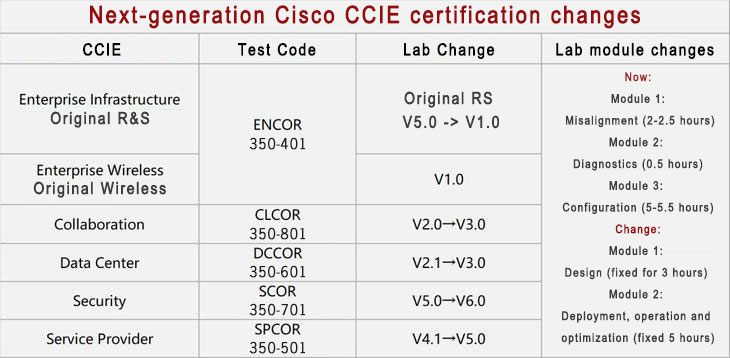
Enterprise Infrastructure (Originally R&S) and Enterprise Wireless (Originally Wireless) take the same IE written test
NP written test and IE written test is the same, take the NP/IE written test can choose to directly take THE LAB to become CCIE or reference an optional examination to become CCNP, the exam is more flexible

LAB exam modules changed from tS-DIAG-Configuration to design-and-deploy, operate and optimize two modules

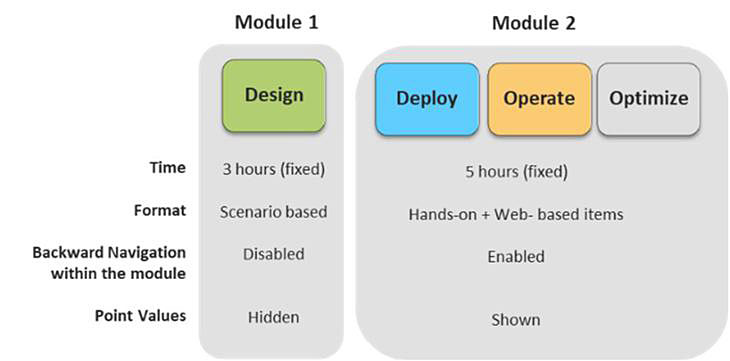
The form of recertification has been changed to 120 credits to be activated, similar to NP certification, requiring only one core exam and one optional exam.
The next generation CCIE is still valid for 3 years, but more than 3 years only need to choose to re-test the written test to activate, no need to test LAB activation
Ten-year honor CCIE changed to 20-year honor CCIE That’s what’s in today’s Cisco workshop, six years of precipitation for the next generation of networking system changes
Summarize
Cisco’s transformation foreshadows a more systematic and diverse certification of the next generation of network engineers, advocating a single-specific (core exam) and multiple (optional exams) that will flexibly choose the direction and content of learning based on their own interests or business needs.
At the same time, there is automation and development in each direction, so that the original relatively simple implementation of delivery engineers have the opportunity to move to a higher level of design and research and development! New changes have brought new challenges, new opportunities, the positive embrace of the new era, but also the best era of our generation of network engineers.
Leads4pass has changed with the times, and now we’re the best! The new era will be even better! Helping everyone is the happiest thing about leads4pass.
[Free Update] Cisco Certified Network Associate 200-301 practice test 2022
Vendor: Cisco
Exam Code: 200-301
Exam Name: Cisco Certified Network Associate
Certification: CCNA
Total Questions: 771 Q&A
Updated on: 2022
Cisco CCNA 200-301 free exam questions and answers are updated in 2022
QUESTION 1
Which mode must be used to configure EtherChannel between two switches without using a negotiation protocol?
A. active
B. on
C. auto
D. desirable
Correct Answer: B
The Static Persistence (or “on” mode) bundles the links unconditionally and no negotiation protocol is used. In this mode, neither PAgP nor LACP packets are sent or received.
QUESTION 2
What is the function of Opportunistic Wireless Encryption in an environment?
A. offer compression
B. increase security by using a WEP connection
C. provide authentication
D. protect traffic on open networks
Correct Answer: D
QUESTION 3
Which two commands can you use to configure an actively negotiate EtherChannel? (Choose two.)
A. channel-group 10 modes on
B. channel-group 10 mode auto
C. channel-group 10 modes passive
D. channel-group 10 mode desirable E. channel-group 10 mode active
Correct Answer: DE
QUESTION 4
DRAG-DROP
Drag and drop the IPv6 addresses from the left onto the corresponding address types on the right.
Select and Place:

Correct Answer:
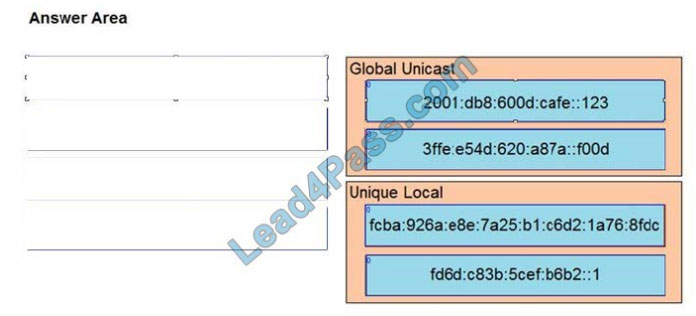
QUESTION 5
Which level of severity must be set to get informational Syslogs?
A. alert
B. critical
C. notice
D. debug
Correct Answer: D
Specifying a level causes messages at that level and numerically lower levels to be displayed at the destination. From Table 3: informational level = 6, debugging level = 7, notice/notifications level = 5 Severity Level 7 – Making informational, notice, Warning, Error, Critical, Alert, Emergency appear in the Syslog
https://www.cisco.com/c/en/us/td/docs/routers/access/wireless/software/guide/SysMsgLogging.html
Cisco CCNA 200-301 free exam questions and answers are updated throughout the year from leads4pass
QUESTION 1
Which type of attack is mitigated by dynamic ARP inspection?
A. DDoS
B. malware
C. man-in-the-middle
D. worm
Correct Answer: C
QUESTION 2
Router A learns the same route from two different neighbors; one of the neighbor routers is an OSPF neighbor, and the
other is an EIGRP neighbor. What is the administrative distance of the route that will be installed in the routing table?
A. 20
B. 90
C. 110
D. 115
Correct Answer: B
The Administrative Distance (AD) of EIGRP is 90 while the AD of OSPF is 110 so the EIGRP route will be chosen to install
into the routing table.
QUESTION 3
Which three statements are typical characteristics of VLAN arrangements? (Choose three.)
A. A new switch has no VLANs configured.
B. Connectivity between VLANs requires a Layer 3 device.
C. VLANs typically decrease the number of collision domains.
D. Each VLAN uses a separate address space.
E. A switch maintains a separate bridging table for each VLAN.
F. VLANs cannot span multiple switches.
Correct Answer: BDE
QUESTION 4
Which statement about Link Aggregation when implementing on a Cisco Wireless LAN Controller is true?
A. The EtherChannel must be configured in “mode active”.
B. When enabled, the WLC bandwidth drops to 500 Mbps.
C. To pass client traffic, two or more ports must be configured.
D. One functional physical port is needed to pass client traffic.
Correct Answer: D
Reference: https://www.cisco.com/c/en/us/td/docs/wireless/controller/8-2/configguide/b_cg82/b_cg82_chapter_010101011.html
QUESTION 5
Which protocol prompts the Wireless LAN Controller to generate its own local web administration SSL certificate for GUI
access?
A. HTTPS
B. RADIUS
C. TACACS+
D. HTTP
Correct Answer: A
[Cisco 200-301 exam question 2022 updated]:https://www.vcecert.com/200-301-dumps-update-2022-real-cisco-ccna-exam-materials/
Get More Cisco CCNA 200-301 exam practice test – > https://www.vcecert.com/cisco-200-301-exam-dumps-and-online-practice-questions-are-available-from-leads4pass/
[Cisco 200-301 exam question 2021.9 updated]: https://www.exam-box.com/the-latest-and-most-popular-cisco-200-301-exam-dumps-to-update-from-leads4pass/
[Cisco 200-301 exam question 2021.8 updated]: https://www.vcecert.com/aug-2021-leads4pass-latest-update-cisco-ccna-200-301-exam-dumps-contain-pdf-and-vce/
[Cisco 200-301 exam question 2021.5 updated]: https://www.vcecert.com/get-13-free-cisco-200-301-exam-questions-and-answers/
[Cisco 200-301 exam question 2021.6 updated]: https://www.examsall.com/cisco-200-301-exam-questions-and-answers-latest-update-real-questions-crack/

